July 26, 2004 — It rests solemnly under floodlights, the centerpiece of the space gallery at the National Museum of the U.S. Air Force in Dayton, Ohio. In 1971 it journeyed to the moon and back on a 12-day flight, carrying its crew of three astronauts on a daring mission of exploration.
The astronauts on that voyage, commander David Scott, command module pilot Al Worden, and lunar module pilot Jim Irwin, were all Air Force officers. And so their Apollo 15 vehicle is honored here, together with other historic Air Force air and spacecraft.
But unlike any other flown Apollo spacecraft on display in museums, the Apollo 15 command module's side hatch is closed. Its interior can only be glimpsed through the small portals of the five spacecraft windows, and then only from a distance.
The restricted interior view isn't meant to frustrate curious museum visitors. It's just that there really isn't much to see inside. A significant part of the ship's interior, including the main control panels, is missing.
Eluding discovery
Where are the Apollo 15 control panels?
The mystery of the panels' fate eluded even those in the museum community. Max Ary, while director of the Kansas Cosmosphere and Space Center, had sought to recover the panels in hopes of restoring Apollo 15.
"We did look in quite a few places," Ary recalled, "including getting up on a lift and looking into the command module on display at the Smithsonian as part of the Apollo-Soyuz Test Project display."
But Ary was never able to find the panels.
"It had become a big mystery for me that I was not able to finalize before I left the Cosmosphere," he said with some frustration.
Panel shell game
Archived NASA documents reveal the long forgotten fate of the panels. The answer to the riddle is at once simple and startling – the Apollo 15 control panels are... well, they are in Apollo 16!
A NASA permission slip for removing hardware from the flown spacecraft tells the tale.
Dated December 11, 1973, more than two years after the Apollo 15 mission and about one and one-half years after Apollo 16 flew, the Apollo Spacecraft Hardware Utilization Request (ASHUR) calls for the removal of panels 1, 2, 3 (the main control panels), 7 (a panel to the commander's left), and 277 (a blank panel), as well as the Guidance and Navigation System Navigation Base (sextant), from Apollo 15.
The reason for the removal of the artifacts is almost as surprising as the revelation itself. The control panels from Apollo 16 (designated CSM-113) had been removed, and replacements were needed to equip Apollo 16 for display at NASA's Marshall Space Flight Center in Alabama.
In fact, a careful look at NASA post-recovery photographs of Apollo 16, compared with later images of the craft on display, reveals that more than just the control panels were changed. The crew's couch was also changed. Apollo 13 and later missions launched with a modified version of the armrests on their couches. But Apollo 16 is now on display with the earlier version.
Pinching NASA pennies
So, now we know what happened to the panels flown on Apollo 15. What happened to the panels and other items flown on Apollo 16?
Part of that answer lies with the NASA policy of removing equipment from its flown spacecraft to use again and save money on future missions. The parts would be tested to ensure flight worthiness and then used again, or set aside as spares.
Although this re-use was practiced throughout the Apollo moon program, it was particularly seen in support of the cash-strapped Skylab and Apollo-Soyuz programs. Flown parts of every kind were removed to provide spares and flight articles for the space station and the joint US-Soviet Union mission.
Additional parts were also needed to complete the docking module that joined the two Apollo-Soyuz spacecraft. Flown floodlights, valves, switches and other parts helped reduce the cost of the unique module. Some time after the flight, the docking module burned up on re-entry, consuming its small collection of previously flown artifacts.
Flown parts were also removed for use in training. When simulator parts wore out and no spares were available, flown parts were downgraded to training status and put to work in the simulators.
In September, 1972 flown panels and lockers from Apollo 13 were placed in the water egress trainer to ensure the high fidelity of the training. When the trainer's side hatch handle gearbox would not work from wear and corrosion, the flown gearbox from the Apollo 15 hatch was removed and installed on the boilerplate. (These parts were later removed from the trainer.)
Parts were also shuffled to prepare spacecraft for display, as seen on Apollo 16. Couches, couch struts, instruments and other items were moved to different spacecraft as the need for display arose. The original parts were removed to support future Apollo flights. Sometimes high fidelity mock-up instruments were substituted for the real ones.
Apollo lives on
The flow of parts did not end with the last Apollo flight. At the conclusion of the Apollo program, many flown Apollo parts streamed into the space shuttle program.
Apollo items as diverse as pouches, lights and switches were transferred to the space shuttle program to pass the money savings along, at least in theory. Parts were to be used for simulators, crew compartment configuration tests, training, and where possible, for flight. Any accumulated spare parts not needed for space shuttle program support or claimed by the Smithsonian Institution were to be sold as surplus.
Control panel toggle switches were in such short supply that NASA transferred its excess panels and switches — whether functional or not — from the Apollo simulators to Rockwell's space division. These parts included spare flight-qualified switches. They were needed for use in shuttle orbiter trainers and simulators. Rockwell technicians would strip panels of any useable switches, circuit breakers and gauges to help outfit trainers, at a significant cost savings.
Many were shocked when they heard that in the 1980s NASA techs had raided the Apollo 17 command module on display at Johnson Space Center for toggle switches. Extra flight-qualified switches were apparently needed to meet the demanding space shuttle launch schedule. But for years NASA had been removing parts from its flown spacecraft to support active operations and test programs. We simply had never witnessed it.
Final resting place
We know the Apollo 15 panels are now in Apollo 16. But where did the flown Apollo 16 panels finally end up?
We need look no further than the Kennedy Space Center, where they are on display in the Apollo/Saturn V Center.
The Apollo 16 panels were installed into CSM-111 — the Apollo-Soyuz U.S. spacecraft — before its mission. NASA documents reveal that engineers were concerned that the original CSM-111 panel toggle switches had never been X-rayed as part of their quality control process. The mission managers had two choices: disassemble the panels and inspect the switches, or use previously flown panels.
To save money they chose to remove the flown Apollo 16 panel assemblies, test them, and install them in CSM-111. So the panels now installed in the Apollo-Soyuz command module actually flew into space twice.
What about the original CSM-111 panels? Most likely they are at a museum in storage or as part of another exhibit. But they were never to have a flight of their own.
Innovation: Key to Apollo's success
The technicians, engineers and managers of Apollo faced a myriad of challenges, especially technical, financial and those relating to the schedule.
Meeting these challenges required innovation, including re-using equipment that was not originally intended to be used more than once. Their skill and ingenuity enabled the marvelous successes of the Apollo Program.
Historic Space Systems designs spacecraft exhibits and simulators, and consults on aerospace subjects. For more information visit their website or e-mail John Fongheiser. |
|
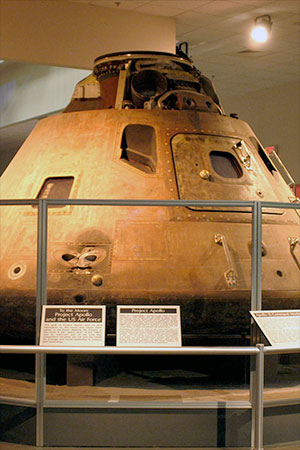
The Apollo 15 command module Endeavor at the National Museum of the U.S. Air Force in Dayton, Ohio. A barrier protects the display but the closed hatch limits visibility of the interior. (USAF)
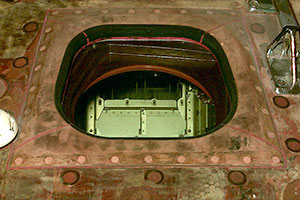
The limited view through the Apollo 15 command module's hatch window reveals the framework for the main console but no control panels. (Historic Space Systems)
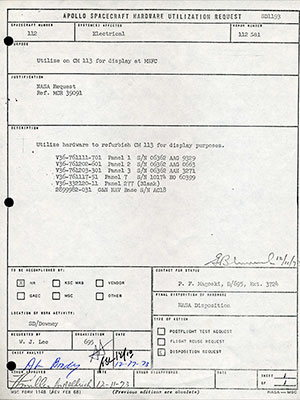
A December 1973 Apollo Spacecraft Hardware Utilization Request (ASHUR) document authorized the removal of the Apollo 15 panels (the CM is designated 112). (Historic Space Systems)
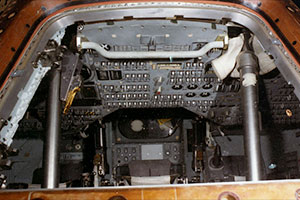
The Apollo 16 spacecraft interior viewed through the open hatch-way, as it was seen on display at the Marshall Space Flight Center in Huntsville, Alabama (today, it is displayed at the U.S. Space and Rocket Center). (Historic Space Systems)
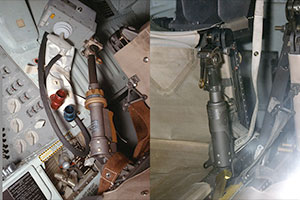
The Apollo 16 commander's area (at left) as seen immediately after the craft's recovery. The design of the armrest differs from the one installed in Apollo 16 for display. (NASA/Historic Space Systems)
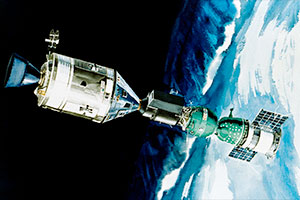
Artist's rendering of the Apollo-Soyuz Test Project (ASTP) in orbit, joined by the docking module at center. Flown Apollo parts were used in the docking module, which burned up on re-entry. (NASA)
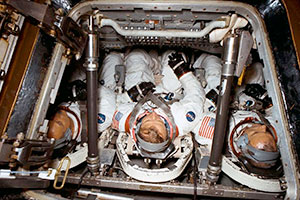
The Apollo-Soyuz astronauts train in the water egress trainer. Do the controls look realistic? They should — the panels surrounding the Apollo-Soyuz crew were flown on an Apollo mission. (NASA) |
